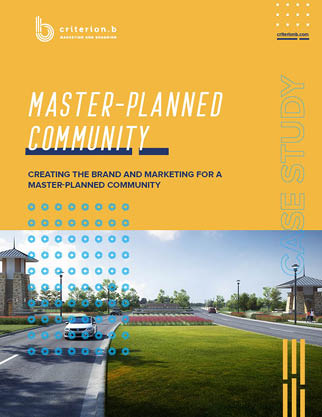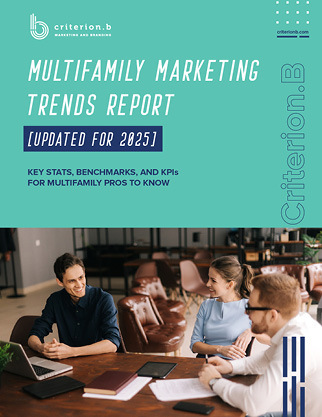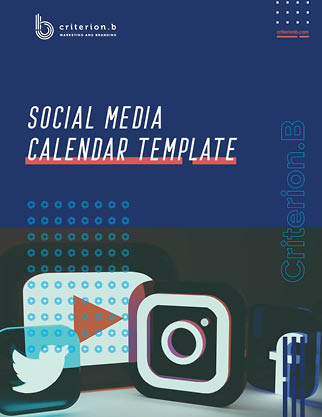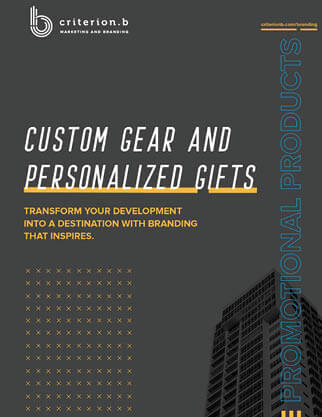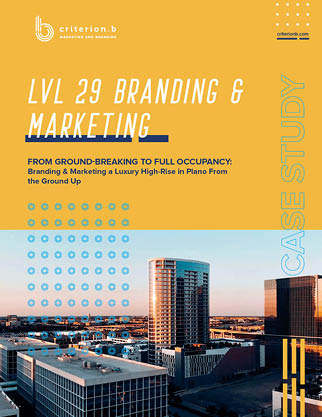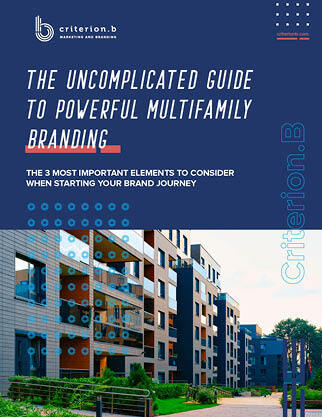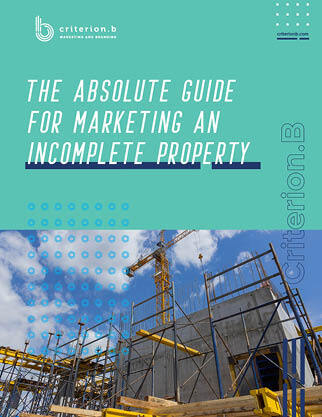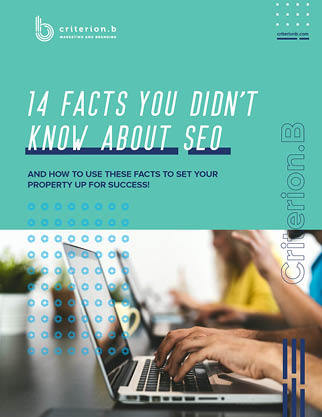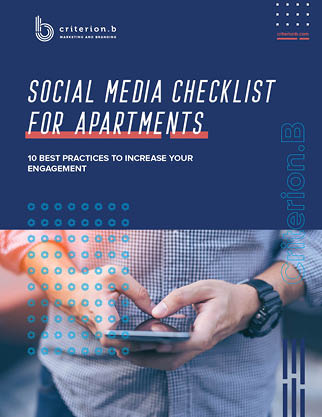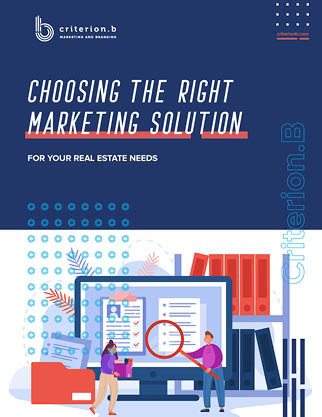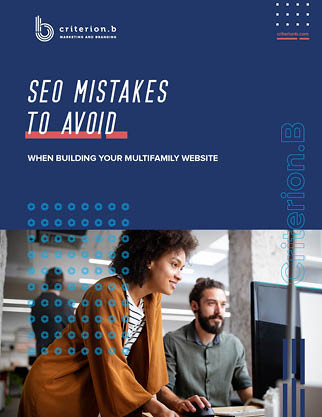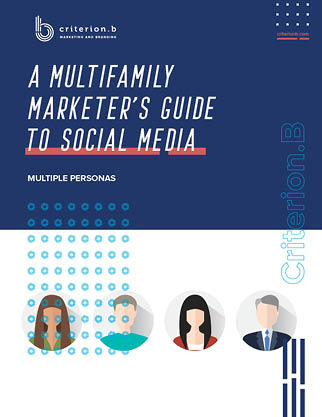Our Agency’s Library of Content, at Your Fingertips
Looking for an easy way to plan out your content for the month? Interested in learning more about multifamily SEO and how it benefits your business? Searching for multifamily branding tips for success? We’ve got you covered. Check out our free online marketing tools to help you better understand your buyer personas.
Gone are the days of a “set-it and forget-it” website. To truly engage your audience you need to know how to write a blog that speaks to them. Business blogging is not just a trendy thing to do, it actually is good for your bottom line.

Consider the following statistics:
- 81% of consumers trust advice and information that they read in blogs.
- Nearly 96% of bloggers promote their service business blog posts via social media.
- 57% of marketers say they’ve gained customers specifically through business blogging.
- Companies who blog receive 97% more links to their website.
- Using images in blog posts gets 94% more views.
In a world where digital consumption is king, there is only one way to fight the battle against your competitors — business blogging and distributing your content for all the world to see.
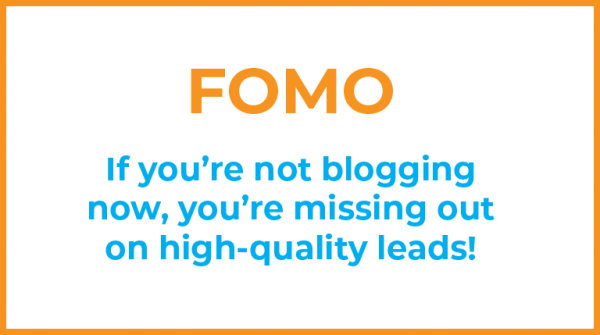
Below, our experienced team of content writers at our multifamily branding agency compiled all of our best business blogging tips for writing and distributing a service business blog.
1. Select your platform
Prior to starting your blog, you must first decide which business blogging platform you would like to use. Some free options include WordPress, Blogger, and Tumblr. However, if you do not care for any of these, you can always search for other business blogging platforms via Google. If you are a business, you should consider hosting a blog within your website in addition to an outside blog site. Through your external blog, you can create inbound links that drive traffic to your company’s website and in turn, means free advertising!

2. Decide on a web design theme
The next is choosing a web design theme for your business blog. Some bloggers like to talk about the industry, others focus on common problems that clients have. One great way to write about solutions to the problems that your customers have is to predict the questions your prospects are Googling.
If you already have your buyer persona built, predicting your customer’s questions and pain points will be a cinch! If not, refer back to some of our previous blogs for simple steps on how to accomplish this.
3. Pick your design template
Now that you have your theme, it’s time to think about the layout and color scheme of your website. Do you want it to be clean? Simple? Elegant? Fun? Creative? Whatever you choose keep your readers in mind, and make sure that there is a synergy between your design and web theme.
If you operate in the multifamily industry and want a beautiful, affordable, and easy-to-implement web theme, be sure to check out our sister company Swifty!
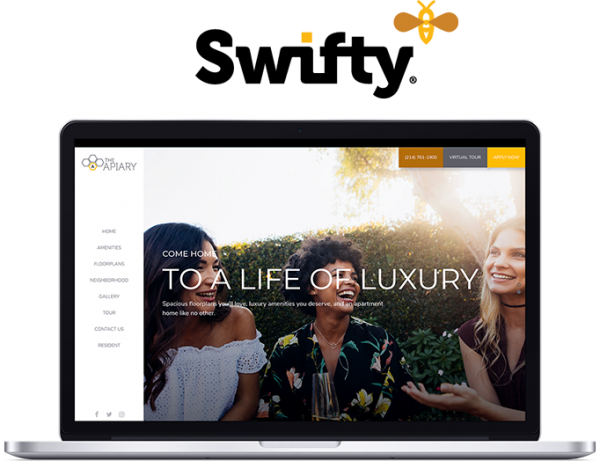
4. Create a content calendar
Once all of this preparation is complete, it’s time to create an editorial calendar. You’ll want to begin by mapping out at least 3 to 6 months at a time. Then, make notes on the calendar for each day you want to post content.
Most importantly, stick to the calendar! Make sure that you create an editorial calendar that is reasonable for your schedule. Do not overwhelm yourself — it will be hard to stick to your goals if you over-commit and in turn will discourage you from writing future content.
However, you should challenge yourself — don’t schedule just one service business blog a month. Once you get into the groove, you will see that you can post more often and the boost in SEO, engagement, and traffic will make it worthwhile.

That being said, your business will struggle if you don’t have a system in place to attract the right kind of audience with the right content at the right time. Your goal is to nurture and convert your audience, not drive them away because you are shelling out the wrong content (and too much of it).
So press pause before pumping out eight articles a day without defining your business goals first. Create a content strategy that will attract your buyer persona and improve their experience.

5. Write away!
Finally, now that you’ve established your blog site, designed your theme and layout, and developed a content calendar, it’s time to put your fingers to the keyboard and write your first business blog.
At first, keep it simple. If you’re not sure how to get started, read through a few established competitor blog sites. Get a feel for the voice you want your service business blog to have.
Research your customers’ pain points and choose topics that will answer their most pertinent questions. Try to keep in mind what your customers are searching for online so that you can position your organization as a trusted resource.
The length of your blog will depend on your buyer persona and their interests, but we typically recommend a blog post length of at least 1,200 words to get the most out of your SEO strategy. The key for your business is to research your persona and conduct interviews to learn what type and length of content are most valuable.
Interested in more tips for creating a highly optimized blog for your business’ SEO? Check out this blog for step-by-step business blogging tips!

How to Distribute Your Blog Content to Reach the Right Audience
Many of our clients ask us about the importance of content marketing and whether they should consider starting a service business blog. Our answer is always a resounding yes.
Not only is consistent content marketing integral for SEO and achieving a higher search ranking, but it’s also a great way to position your business as an expert resource to customers.
However, distributing content is more important than writing content. In fact, promoting a blog can often take more time than writing the actual content. This is particularly true for businesses that do not have a corporate team of writers and marketers on hand.
To make the blog worth the time and effort of your team, it’s critical to distribute the content effectively and obtain as much use from the blog as possible. For example, a single blog post can be shared on Twitter with a snappy headline, extended to Instagram with an engaging image, and adapted to a shareable infographic.

Below are a few ways you can get the most bang for your blog:
Organic Distribution via Social Media
One of the biggest perks of social media as a marketing channel is the ability to create an engaged, online community of the individuals that build up your target audience.
- Social Sharing Buttons — Allow your website visitors to read your content and share it with their friends. The not-so-savvy internet users, or even the lazy ones, will rarely copy your URL and post it on their social pages, so make it easy for them to share your content.
- Business Social Accounts — Share all of your blogs through your social accounts. Write a one-line teaser that will encourage them to click on the link and include a blog graphic to give your audience a visual representation.
- Connections — Connecting with influencers in your respective industry is important to building a solid blog following. Find people on social media that you know will be interested in your content and reach out to them so they can have easy access to your service business blog.
Email Marketing Distribution
Like your RSS Feed, you should encourage your website visitors to subscribe to your email list. Once you capture those email addresses you can send out monthly newsletters that feature your most relevant blog posts and drive traffic back to your website.
Content Syndication
It’s important to build relationships with relevant blogs, brands, or publishers. This ultimately builds your brand and makes your blog awareness a lot higher than others. Asking others to link to your content in return for you linking back to their content gives you a connection that benefits both parties. This strategy is very important because it allows other bloggers to endorse you and build a bigger audience.
Paid Distribution
Paid advertisement distribution on Facebook is fairly simple to use and necessary in today’s digital marketing world. Digital marketing gets difficult when organic reach on Facebook decreases, so use paid distribution to your advantage.
Reshare Regularly
Not all of your potential customers are online or on the same social channel at the same time. Additionally, a customer might have read your article the first time and forgot to save it or forward it along to their co-worker. For these reasons, it’s essential that you reshare your content regularly across your social media and even in your newsletter.
Include an “In Case You Missed It” section in your newsletter that highlights previous popular blogs. Choose several one-line teasers or important quotes from your article and schedule tweets throughout the month. Adjust the ad set and re-run your Facebook ad to get your content in front of an even broader audience.
Make It Visual
Infographics provide significant value from a content-supporting standpoint. Companies are constantly generating content, but the bulk of it is often heavy and wordy. Focus on utilizing the visual aspect of infographics to break up the content. Pull important statistics and tidbits of information from your in-depth service business blog and build out an enticing infographic that users can easily download and view.
Additionally, pull out some other short quotes or statistics to create an eye-popping graphic that you can share on Instagram and Pinterest. Considering you cannot share links in your Instagram posts, prompting users to click the link in your profile is a great way to promote your service business blog.
Making the Most of Your Business Blogging
Business blogging is no easy task, but with these tips in mind, you are well equipped to make the most of your time and effort by expanding the reach of your content.

5 Steps to Improve Your Multifamily Marketing Analytics Strategy
The world of digital marketing analytics is always changing, making it difficult to understand the correlation between ad dollars spent and revenue. As a multifamily agency, we know there is not a one-to-one correlation between the two, and it is nearly impossible to prove to upper management that our efforts are actually worth the investment.
The tracking and analyzing of your content mix to measure return on investment (ROI) is what digital marketing analytics is all about. And thankfully, there is no shortage of multifamily marketing resources to help collect and manage these data points.
Gearing Up With the Right Digital Marketing Analytics Tools
Google Analytics
Google Analytics is a free tool marketers use to track their multifamily website or app. While the interface seems daunting at first, this tool allows you to seamlessly monitor everything from the demographics and behavior of site visitors to bounce rate and what they are clicking on the most.
Social media insights
Most social media platforms offer their own analytics if you have a business account. Social media insights allow you to measure post reach, follower demographics, engagement and interactions, and even what time of the day your followers are most active. Additionally, you can track ad spend, cost per click, and more through Facebook’s Business Settings.
Hootsuite and Buffer
While Hootsuite and Buffer offer free platforms for social media management, the paid memberships allow you the ability to track all of your social media analytics on a single dashboard. Rather than logging into each of your social accounts to schedule posts individually, these platforms also give you the ability to schedule posts across multiple platforms from a single app.
Multifamily marketing automation software
While there are several tools to track digital marketing analytics, HubSpot, SharpSpring, and other marketing automation software allow you to wrap all of these into one. With these platforms, you can schedule-out email campaigns, social media posts, blogs, and more as well as track the digital marketing analytics for all of them.

Practicing Patience With Digital Marketing Analytics
Just as “a watched pot never boils,” you cannot expect to see immediate results from your multifamily marketing efforts. Patience is key as you track the success of your labor.
More likely than not, you will not see significant progress within the first week, month, or even quarter. Successful multifamily marketing takes time. While you should track items daily such as Facebook ad conversions or clicks on a CTA for your weekly e-newsletter, it is more important to monitor these metrics over a more extended time to see real improvement.
For example, your Facebook Business Page may receive 60 new followers in one week but only a handful the next. The change in followers is not necessarily a reason to be concerned, but it is a trend you should track closely to discover why your followers did not increase as much as in previous weeks.

After all, when you spend countless hours each month planning, scheduling, managing, and tracking your content marketing analytics, there’s no better way to enjoy the fruits of your labor (like increased ROI) than to track and improve your strategy continually. The key is to not get frustrated with your digital marketing analytics results. Stay patient and keep tracking.
How to Improve Your Digital Marketing Analytics Strategy
Reaching your buyer persona in the right place at the right time is paramount to multifamily marketing success, and digital marketing analytics are essential to the evaluation stage of any apartment marketing strategy. However, if not collected diligently, they are of no use.
If you are not achieving your multifamily marketing goals or seeing the results you want from your efforts, it’s time to adjust your strategy. The following are a few good practices to make habits that will increase your data’s relevance:
1. Identify your problem areas
First, decide where you could use some improvement. Focus your efforts on a few specific areas such as social media engagement or website traffic to track relevant data for your business.
2. Create SMART goals
To prove your analytics efforts are worth your time, you have to set SMART goals — Specific, Measurable, Achievable, Relevant, and Timely. This way, you can continue to track your progress in comparison to your end goals. Without this step, there is no way to assess the performance of the strategy you have put in place.
3. Stay committed
Now that you have the groundwork set, here comes the hard part — staying fully committed and on track with the goals you set. Tracking and reporting your analytics data weekly as well as monthly, quarterly, and yearly is crucial to finding different trends, so stay committed. Pausing your efforts or adding multiple layers to your pre-constructed plan will only lessen your impact.
4. Track your digital marketing analytics
Follow different trends in your digital marketing analytics data and make adjustments accordingly. Then, track and report the results to find new insights. Luckily, there are a variety of digital marketing analytics tools to help you with this crucial step.

5. Report and repeat
Successful multifamily marketing is a long, winding road of strategy, testing, retesting, and careful planning. When you have met your goals, report your data to your team and set new ones.
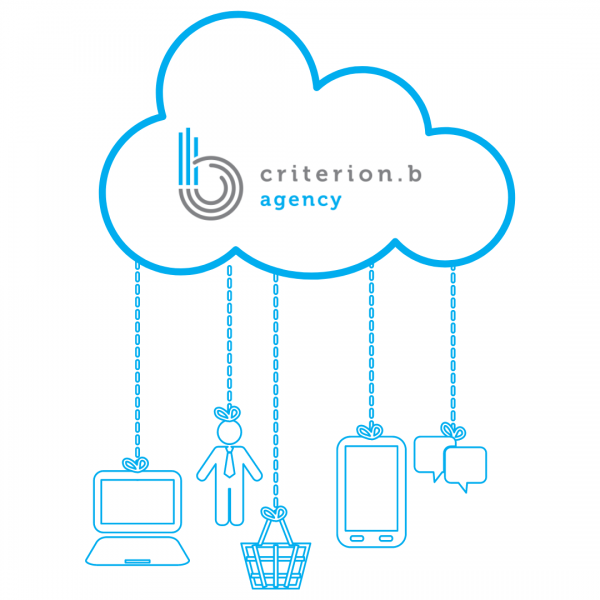
Trust the Experts to Become the Experts
Use digital marketing analytics to make informed decisions about the time, place, and manner in which you advertise. This way you can focus your ad spending in specific areas, to better reach your target audience and improve the value of your multifamily marketing.
Remember, if implementing and executing a successful multifamily marketing campaign is not your business’ specialty, you do not have to go at it alone. You can leave the heavy lifting to a multifamily marketing agency like Criterion.B. You spent time and energy creating multifamily branding that offers a unique value proposition, so now it is time to trust the experts to develop a multifamily marketing mix that sends the right message to the right people.
Not sure if your apartment marketing strategy needs the boost of working with a multifamily marketing agency? Check out our worksheet that helps you identify where your business’ apartment marketing strategy stands!

Any new business plan starts by assessing the environment and the opportunities ahead. What’s in store for multifamily marketing for the remainder of this year? What goals can we set? How can we achieve them?
We surveyed the digital multifamily marketing environment and made predictions for the remainder of this year and beyond.
We’ve settled on the four multifamily marketing trends we project to have the most impact and potential this year:

1. Customer Storytelling
Oftentimes, it can be hard to develop a multifamily brand story, especially if our product or service is not outwardly life-changing.
What’s your multifamily brand story? And by that, we mean, what makes your multifamily brand human? How do you care for your customers and your community?
For some organizations, their brand story is an easy one to tell. For example, TOMS donates a pair of shoes for every pair sold, and St. Jude’s helps children fight cancer every day. It is easy to see how these organizations have an impact on people’s lives.
But what about the rest of us? The bankers, the chefs, the designers, the agency owners, and so on … What’s our mark on the community? How do we care?
Oftentimes, it can be hard to develop a multifamily brand story, especially if our product or service is not outwardly life-changing. That’s why we love this example from Airbnb:
Airbnb is all about the customer, which makes obvious sense considering the customer (both hosts and guests) is the brand. The company does not manage or own the properties on its platform; rather, the company offers a platform for customers to book or promote properties, meals, experiences, and more.
Airbnb knows that if no one is using the platform, the company does not have a product. This is why it’s critical for the company to utilize customer storytelling to build its brand. In fact, the platform has an entire section titled “Stories From the Airbnb Community” for this very purpose.
Positioning the customer at the center of its brand and letting the customers be the brand is essential to Airbnb’s philosophy and identity. The company is literally built on the power of customer storytelling.
Mobilize your advocates and go beyond the standard
There is a quote we often recite in our office and try to remember in our multifamily marketing efforts, “People don’t buy what you do, but rather why you do it.” 2021 is the year to mobilize your advocates — that is, your loyalists and your enthusiasts.
What role does your multifamily brand play in people’s lives? Create a forum for your customers to tell their brand story (i.e., what they love about your brand). Livestreaming and takeovers on Instagram, Facebook, and TikTok will continue to be the breakout social platforms for customer storytelling. Go beyond the standard “Post a photo.” Challenge your advocates.
It all goes back to this: how do your customers connect with your brand? Now, how can we leverage those connections to tell our multifamily brand story?
2. New Data Collaborations
Another significant digital multifamily marketing trend to keep on your watchlist is new data collaborations — that is, how “hard data” will no longer rule the roost. It’s going to be a year of collaboration and teamwork. Hard and soft data, big and small data, quantitative and qualitative … no matter how you look at it, marketers must use both to find digital multifamily marketing success.
Hard and soft data
Let’s start by differentiating between the two. Hard data is quantitative in nature, meaning that it can be precisely measured. It’s usually collected on a large scale, which allows us to quantify and organize the data we collect. With hard data insights, I know that 60% of my customer base is female, 32% is Hispanic, and 10% make $200,000+ each year, etc. Hard data tells me that 40% of my web traffic is coming from a single blog post. Or that 72% of my online customers are finding me through social media.
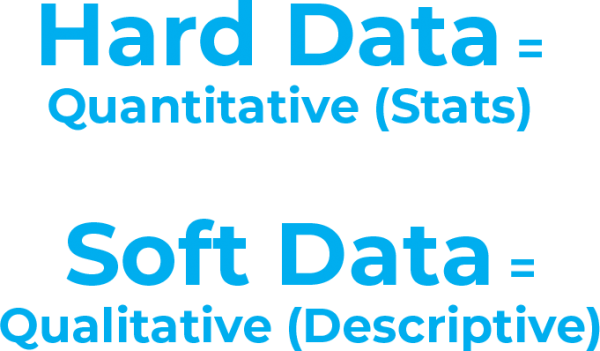
On the other hand, soft data (or qualitative data) is descriptive, intangible, and hard to measure. It also goes much deeper than hard data. Soft data is often gathered from interviews, observations, or from spending time with people. While hard data tells me that 60% of my customer base is female, soft data focuses on just a few of my female customers in an effort to understand:
- How do they use technology throughout the day?
- What are their perceptions of my brand?
- Who do they trust most for product recommendations?
If hard data tells me that one of my blog posts is driving 40% of my web traffic, soft data tells me why that blog is effective.
Nail your value proposition
Traditionally, multifamily marketing and advertising have been a hard-data world. Recently, however, there’s increasing awareness of the value of soft data. Without soft data insights, we will never really know our customers or our target audience. We will never know what is important to them, what they do on the weekends, or what keeps them up at night. Why do these things matter?
Because without these soft data insights, we do not truly know our value proposition. We do not know what problems we are trying to solve for our target audience. We do not know the best way to appeal or intercept them — what kind of technology, what message?
Cue your resident buyer personas …
In the section above, we talked about brand advocacy — that is, when customers voluntarily and excitedly recommend your brand to others (AKA the multifamily marketing mecca). To get there, you have to know what makes your customers tick.
One way to do this is through resident buyer personas. A persona is a semi-fictional character you create that epitomizes your customer. It captures their demographics, behaviors, and motivations. Not only does it summarize your target market, but it gives you “someone” tangible to market to. A resident buyer persona starts with hard data, then adds the soft data insights.

Role Play: Luxury Apartment
Let’s pretend you are the multifamily marketing coordinator for a luxury apartment complex in Uptown Dallas. You are trying to determine how to attract more young professionals, so you hold a small focus group with a few of your current residents. You ask them questions that aim to understand the “why.” Why did they choose this apartment? Why did they renew their lease? What’s the value of living here for them?
You then emerge with a few character profiles that read something like this …

Chris is 28 years old, single, and living in a one-bedroom apartment in Uptown Dallas. He’s originally from Chicago, but he stayed in Dallas after college for a job opportunity.
By day, he’s a financial analyst; however, every evening, you can find him at the CrossFit gym. He enjoys the camaraderie of CrossFit, and he frequents The Pickled Sub, a sandwich shop two blocks east. He always knew he wanted to live in Uptown, where he can walk to nearby grocery stores and restaurants.
His life revolves around Champ, his active three-year-old dog, who he likes to take out for runs. At his current location, the Katy Trail is 100 yards out the back door and the dog groomer is two blocks north. His dog sheds, yet he’s found these hardwood floors easier to keep clean than the carpet in his previous apartment. He’s gotten to know fellow pet owners throughout the apartment complex, with whom he enjoys the small talk that surrounds pet-owner responsibilities.
BOOM. You just got the angle for your new multifamily marketing materials. Remember that Chris does not actually exist. This persona was created from several conversations with residents. Hard data found that 34% of the residents were single, male, pet owners. Soft data revealed why they live there, and how you can continue to attract them. A persona gives you someone tangible to market to.
It’s teamwork, you see, between hard and soft data, big and small, quantitative and qualitative. We will see a lot more data collaboration this year. Why? Because it produces killer insights.
Want to learn more about the importance of building your buyer persona, including free resources like checklists, guides, quizzes, and more to help you do so? Check out our list of free buyer persona resources to help you get started!
3. Multifamily Inbound Marketing
This term, inbound multifamily marketing, has become more prevalent in the last year or so. Inbound multifamily marketing methods focus on content creation (e.g., blogging) as a way to attract your target audience and establish yourself as a resource within your industry or community. In turn, regular blogging serves to boost your multifamily SEO and drive media interest. It also provides points of engagement on social media.
Inbound multifamily marketing is a pull method rather than the push method of traditional apartment advertising. The prevalence of inbound multifamily marketing has necessarily given rise to a new trend: ongoing content creation.

New kids on the block
No longer is blogging merely a novelty multifamily marketing tactic. Instead, blogging has become essential to businesses in the digital age. (Just ask us how our last few clients found us!)
As the journalistic landscape evolves, we will see traditional writers and editors start to fill demand on the creative side. Businesses need more than just “a writer” these days. They need an editorial vision. They need someone who knows how to tell a multifamily brand story and then translate that story to several platforms. Journalism provides an excellent skill set for storytelling. This is why we’ll start to see content creation within agencies and businesses become more of a journalistic process.

By the end of 2021, we would not be surprised to see multifamily companies running their own little newsrooms! Lord knows that multifamily marketing agencies already are!
4. Context-Aware Advertising
Location, location, location. You have heard it before, but how will it drive digital multifamily marketing in 2021 and beyond? You’re about to find out.
Context awareness will be a major apartment advertising trend to keep an eye on this year. As the name suggests, context-aware apartment advertising takes into account your location (along with other publicized information) to serve you ads that are hyper-relevant and thus, more likely to convert.
Imagine all the applications … Consumers can receive coupons (e.g., half-price frozen yogurt, $10 off shoes) as they enter the vicinity of a store. Even small businesses inherit the power to be relevant and connect with consumers at the most actionable time (i.e., when they are standing outside of the store).
Consider beacons that stores sometimes use, and this scenario — already pretty realistic — becomes all the more possible:

Predictably, there are several privacy debates currently surrounding location-based advertisements, which require consumers to somehow “opt-in” to location-based ads or make their location public. Oftentimes, however, consumers may not be aware that they have “opted in.” Other privacy concerns include the ease of “opting out,” which the Digital Advertising Alliance (DAA) is currently sorting out.
From a multifamily marketer’s perspective, the technology is exciting. Now how to make context-aware apartment advertising work for you?
The key to effective ads (redefine context)
To deliver effective context-aware ads, you do not necessarily need access to personal information. Instead, think broadly.
Context-aware apartment advertising can also pull from other dynamic feeds, such as weather, stock prices, or breaking news. For example, if I own a local ice cream shop, my ads would probably be best served on sunny days when the weather is 80+ degrees. A student housing apartment complex is best promoted in July and August as the new semester begins. So on and so forth.
Think about what makes your product relevant to your customers, then capitalize on the context.
Ultimately, to stay on the pulse of digital multifamily marketing trends, you must first know who your target audience is and make them the center of your multifamily marketing and apartment advertising efforts.

6 Marketing Ideas for Apartments to Incorporate Into Your Facebook Strategy (#3 Might Give You a New Perspective)
Despite the economic climate, now is not the time for apartment communities to ignore social media.
In fact, Atlanta-based RangeWater Real Estate decided not to cut its budget in early 2020 at the start of the COVID-19 pandemic — a risky decision for an apartment marketer to make during a global crisis.

However, this seemingly “big risk” reaped big rewards for RangeWater Real Estate. The company saw a 35% increase in overall impression share across most of its submarkets between April and May 2020. Additionally, the company’s apartment communities appeared on Page 1 of search results more frequently than before — the ultimate win for any property.
In short, RangeWater was able to attract a larger percentage of leads using the same budget despite a huge upheaval in the economy. How did they accomplish this?
Below, we’ve compiled some of our best marketing ideas for apartments and how to effectively use Facebook to bolster your apartment marketing strategy.
Making the Most of Your Facebook Strategy
Facebook connects more people with businesses than any company ever has in the past. Businesses know this fact, which has caused brands to constantly rethink their Facebook strategy every year.
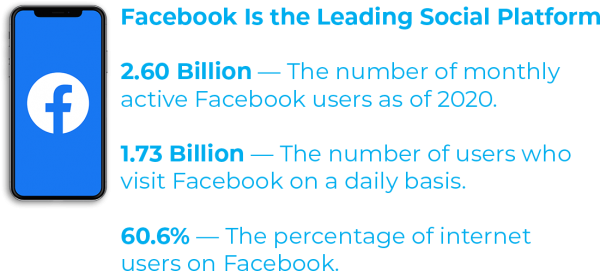
Are Your Residents Still on Facebook?
Despite trendy platforms like Snapchat and TikTok gaining popularity among young adults, Facebook is still a relevant social media channel among your renters. According to Statista data, 65% of Facebook users are under the age of 35. This means your millennial and generation Z residents still use Facebook actively.

However, as the multifamily market shifts and renters’ needs evolve, so too does Facebook. It’s critical for multifamily marketers to stay ahead of the game to ensure they make the most of their Facebook strategy.
But even knowing how important social media is, how can you best use Facebook to your marketing advantage? Below, we’ve outlined some of our top marketing ideas for apartments and how to incorporate these tips into your Facebook strategy:
1. Always remember the 80/20 Rule.
Social media management should be treated like a cocktail party. You need to take the time to meet the other people at the party (residents, neighborhood businesses, new millennials, Gen Z renters, etc.) rather than monopolize the conversation. Only when the conversation presents itself should you share what makes your community so great.
From recommendations and leasing details to customer service and reviews, renters are turning to social media for property information, and this trend will only continue as a younger, social-media-savvy generation gets older.
In the meantime, be a resource for your residents. Publish fresh, helpful content to inspire and engage your current and prospective residents.
2. Practice patience and consistently engage with your followers.
Years ago, you were finding residents. Nowadays, residents are finding you. People are searching online for places to live, and it has become the apartment’s job to intercept them. You do this by providing fresh content, sharing helpful information, and having conversations.
Multifamily professionals who have dabbled in social media will claim that it doesn’t bring them any conversions. However, keep in mind that social media is not about the sale; it’s about engagement and customer experience. When you successfully and consistently engage with your residents online and share quality content, their byproducts are relationships, referrals, leases, and retention.

Any good salesman will tell you that relationship-building drives sales. And Facebook is an optimal relationship-building platform.
3. Focus on the qualitative aspects of your residents.
Who are your residents? We don’t just mean demographically, although that too can be important. Instead, you really want to focus more on the qualitative aspects of your residents.
- What kind of lifestyle do they have?
- What are their hobbies?
- What are the things that cause them stress or trouble as residents?
This is where your resident buyer personas come in handy. If your community is home to several working professionals, helpful content may come in the form of quick-and-easy dinner recipes. If your community is home to several dog owners, you could share an interactive map of the dog parks in your city. The information you share should be a mix of content you create and content you aggregate.

4. Share community events and partner with local businesses.
Your residents shouldn’t have to rely on the local news for happenings. Are there any upcoming events that you can pass along to your residents — festivals, charity events, happy hours? Find things that are within walking distance or close proximity to your property.
Sharing helpful content could be as simple as re-posting farmer’s market hours, sharing restaurant specials, or providing tips and tricks for navigating the local flea market. Searching Facebook events for local on-goings is another great and easy way to find shareable content your residents will find useful.
You could also try partnering with local businesses to arrange special discounts for your residents; this provides great content for sharing on Facebook.
5. Publish property updates.
Yes, we know we’ve advised against talking about yourself, however, this form of self-promotion is very different. Instead of telling everyone how great you are, show them.
Try posting photos from last week’s movie event showcases, or get some shots of residents enjoying a nice day by the pool. Are you giving away free donuts and orange juice in the leasing office? Share that, too! Your property’s social calendar paints a picture of resident life and engagement, and it gives insight into your property culture. Isn’t that what you’d like new residents to stumble upon when they’re researching your property?
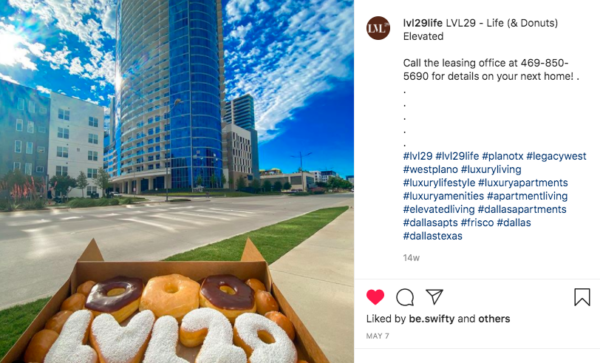
6. Take advantage of Facebook Advertising to bring in more apartment leads.
A social presence is a great tool for properties looking to improve their lease-up. But sometimes, just posting and sharing isn’t enough. Without a decent following or active residents, your social media efforts might be falling on deaf ears. Thankfully, there’s Facebook Advertising to help.
Facebook brought in $17.44 billion in ad revenue in the first quarter of 2020, a 17% year-over-year increase from the first quarter of 2019.
Facebook did experience a “significant” fall in the demand for advertising in March amid COVID-19, but data from April indicates that demand is already returning to normal.
Paid social media ads can seem overwhelming or a huge investment, but Facebook has done a great job of making its ads cheap and available to a wide audience. There is any number of ad types to run, and they can make a difference in giving your social media reach.
If your Facebook is new, a “Page Likes” campaign can be key to helping you get followers that will see your content by encouraging them to like your page. This can greatly increase your reach for a couple of dollars per like.

Similarly, if you have a particularly well-performing, helpful piece of content, boosting that post for a few dollars can expand its reach to hundreds or thousands of others in your area. While you should not dump all your time and resources into ads, running some every so often can be key to giving your Facebook strategy that extra edge it needs.
You can also launch a giveaway campaign to promote Page Likes. Last year, Criterion.B hosted a Facebook giveaway for one apartment community client. The giveaway consisted of a swag basket followers could win by liking the apartment community’s Facebook Page and tagging their friends in the post to increase awareness.
At the start of the campaign, the apartment community had only 450 Likes. Within two months, that number increased to nearly 700.
Convert More Apartment Leads Into Leases With a Successful Facebook Strategy
The benefits of utilizing Facebook are two-fold: not only does it foster resident relationships (and retention), but it provides a window for prospective residents to peer into your community. With Facebook, we embrace this customer-centric approach that lays the foundation for all of our digital multifamily marketing efforts.
With the right Facebook strategy and these marketing ideas for apartments, you can better position yourself to become a valued resource for followers and ultimately convert more apartment leads into tours and leases.

3 Digital Multifamily Marketing Fundamentals You Need to Focus on Today
Digital multifamily marketing is constantly evolving. To keep up, you need a solid foundation and the capacity to think critically, act independently, and be relentlessly creative.
There are three main facets of digital multifamily marketing that businesses should focus on — social media, multifamily SEO, and paid search.

Below, we’ve highlighted those three facets and steps you can take to launch a successful digital multifamily marketing strategy.
1. Kickstart your digital multifamily marketing strategy with social media.
Of course, we are all too aware of Facebook and Instagram, but why should a multifamily marketer really care about social media? Audience accessibility.
Companies can interact directly with their customers for free, and in a way that others can easily view. Social media is a great way to get your multifamily organization’s name out — be it through giveaways, funny interactions with anyone who reaches out to your company or posting videos or photos.
Start by researching which platforms your resident buyer persona(s) use on a daily basis. Are you targeting commercial real estate professionals? Then, LinkedIn and Facebook might be your go-to digital multifamily marketing channels. Is your audience younger millennials who work in an apartment leasing office? Instagram, Facebook, and Pinterest might be more in your lane.
Need a little help with your persona development? Our CEO Jon Simpson breaks down the basics in this helpful video:
After researching your target audience, create your preferred social accounts and fill in all the About Us details. It’s important not just to slap your tagline and phone number on your social media pages, then forget about it. Add details about your services, business hours, and more.
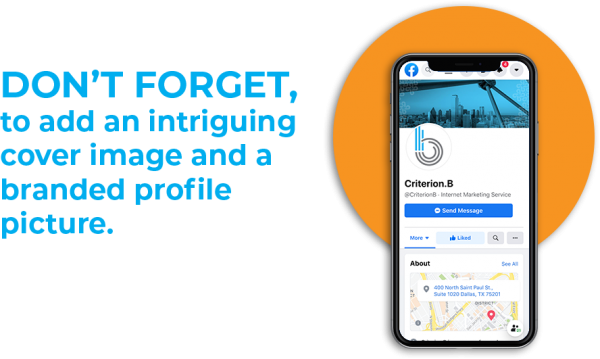
Next, start strategizing your social media postings. Create a calendar that details what you will be posting and when to help keep yourself accountable and organized.
Create a free Buffer account or use Hootsuite to schedule your posts a week at a time easily; that way, you won’t have to remember to publish content each day.
2. Multifamily SEO is the way to go.
Now for the more technology-focused digital multifamily marketing options — SEO and paid search.
The technical way to explain multifamily SEO is that programmers optimize the coding of your website to help it appear higher on organic search results on search engines.
Let’s say you are Googling apartment communities in Dallas, and you see that the link to your company’s website is on the third page of search results. Do you really want that to happen? No! So, you call up your friends at Criterion.B and ask for help. With some magical clicks on our keyboards, we optimize your website so — POOF! — it appears in the top results.
What’s awesome is that if your website appears in the top results, searchers are 31.7% more likely to click on it. This means that people are 31.7% more likely to learn about your company and definitely fall in love with your multifamily product or service. Additionally, if your page is the No. 1 organic result, it’s 10 times more likely to receive a click as compared with a result in the No. 10 spot.
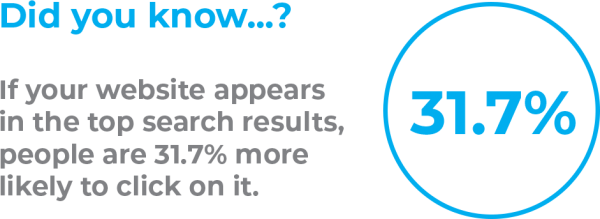
Beyond the expert work of Criterion.B, there are several simple steps you can take yourself to enhance your multifamily SEO. Here are a few tips we recommend to get started:
- Optimize Your Blog Titles — The optimal length for blog headlines is 8 to 14 words, and they should include one H1 tag and a main long-tail keyword that your blog is targeting.
- Add Alt Tags, a Title Tag, and Meta Description to All Pages — Implementing these three portions to your blog images and pages can significantly boost your web optimization.
- Target Two Long-Tail Keywords Per Blog — 50% of search queries contain four or more words.
- Increase Your Word Count to Increase Your SEO — Sometimes, the key to ranking higher in search results is upping your word count to increase your keyword usage without being flagged for keyword stuffing.
For an in-depth look at multifamily SEO and common mistakes multifamily marketers make, check out this blog.
3. See results pour in with multifamily PPC (pay per click).
Paid search, or pay per click (PPC), is kind of like SEO in that both want a link to your company’s multifamily website in the first few results on search engines. However, the main difference with multifamily PPC is that you pay for your link’s spot in targeted organic searches.
Strategy-wise, this is absolutely brilliant because you can pay for a link to your company’s multifamily website to appear when someone searches for your competitor. You can also have it appear when someone searches for something related to your complex.
So, say you own an apartment complex with an outdoor pool area. You can pay for a link to your website to appear when someone searches “downtown apartments Dallas” or “apartments with a pool in Dallas.”
Digital Multifamily Marketing Made Simple
Congrats! Now that you are officially no longer an online marketing beginner, get out there and educate the world with your newfound knowledge. Maybe you can show off some of your new social media knowledge and tweet about it. The key to success with digital multifamily marketing is to have an integrated strategy that speaks to your customer in ways they want.

Millennials & the Multifamily Vendor Landscape: An Investment Primer
The multifamily industry is currently witnessing a massive demand upheaval, driven significantly by the millennial generation. As these young adults progress in their careers and start families, multifamily vendors, from property management software providers to developers, have a golden opportunity. But how can these vendors best navigate the evolving demands of this massive demographic?

Understanding the Millennial Shift
Millennials are the largest generation in America, with about 92 million people outpacing Gen Z, Gen X, and Baby Boomers. This generation, renowned for challenging the status quo, has redefined several societal norms. They’re choosing to tie the knot later — only 28% were married between the ages of 18 and 33 in 2014, as opposed to 49% of Baby Boomers at the same age. This delay in traditional milestones extends to having children as well.
For multifamily vendors, this demographic alteration is a clarion call. Between Q1 2020 and Q1 2022, new households swelled by 1.6 million, largely constituted by millennials. Their preference for larger suburban spaces with access to top-tier schools is clear, but financial barriers and supply shortages present formidable challenges.
Market Dynamics: The Millennial Dilemma
The U.S. housing prices shot up by 18.3% from May 2021 to May 2022. With limited supply and intensifying competition, first-time homebuyers, predominantly millennials, face an uphill battle. Add to this, mortgage rates are soaring.
Considering these dynamics, multifamily vendors need to recognize a crucial fact: for many millennials, renting is not just a choice; it’s the only viable option. This generation is cornered by financial constraints on one side and their aspirations for a comfortable living on the other. They’re caught between a rock and a hard place, and multifamily vendors have the opportunity to be their solution.
Catering to the Millennial Renting Demand
So, how should multifamily vendors position themselves to capitalize on this trend? The answer lies in understanding and catering to millennial preferences:
- Embrace Technology: Millennials demand seamless digital experiences. Property management software providers should focus on intuitive user interfaces and incorporate features that allow easy online payments, maintenance requests, and community engagements.
- Amenities & Workspaces: With remote work becoming increasingly prevalent, multifamily developers and contractors can prioritize building coworking spaces within communities, catering to millennials who may not always work from a traditional office.
- Engage Online: Millennials research extensively online before making decisions. Ratings agencies and developers must ensure a robust online presence filled with reviews, testimonials, and immersive virtual tours.
- Prioritize Sustainability: This generation is environmentally conscious. Developers and contractors focusing on green building practices will find favor with millennial renters.
- Single-Family Rentals (SFRs): For millennials starting families, SFRs in suburban areas offer the ideal blend of space and affordability. Vendors should recognize the increasing value of such properties, given the barriers millennials face in buying stand-alone homes.
The Millennial Opportunity
In an economic landscape fraught with challenges, multifamily investments offer a beacon of stability, particularly in the vendor space. Millennial demand is not a fleeting trend; it’s a consistent shift backed by strong demographic data.
For vendors, the message is clear: now is the time to pivot, innovate, and cater your multifamily marketing efforts to this demographic. After all, people will always need a place to live, and millennials present a ripe opportunity for the industry with their unique challenges and aspirations.

How to Utilize Multifamily Content Marketing to Generate Traffic
The term multifamily inbound marketing is not a new method, but it is a method that still confuses many businesses.
Multifamily inbound marketing methods focus on content creation (e.g., blogging) as a way to attract your target audience and establish your business as a resource within your industry. In turn, regular blogging serves to boost search engine rankings, drive media interest, and provides points of engagement on social media.

Inbound multifamily marketing is a pull method, rather than the push method of traditional advertising, and it all comes down to one very important strategy: ongoing content creation.
When we talk about content, we are simply talking about information. In this case, content is any form of online information that you provide: blog posts, infographics, photo galleries, interactive maps, social media messages, aggregated articles, etc. The most important thing about content is that when it is done right, it does not focus on you; it focuses on your customers.
1. Start a Consistent Blogging Strategy
Great content delivers to your resident buyer persona the exact information they need, when and where they need it. One of the best ways to accomplish this is with a blog. Let’s take a look at a few important statistics:
- Websites with a blog often have 434% more indexed pages.
- B2B marketers with blogs receive 67% more leads than those who do not.
- Marketers who blog regularly are 13 times more likely to achieve a positive ROI.
- Blogs are rated the fifth most trusted source for accurate online information.
While 53% of marketers claim blogging is their top priority when it comes to content marketing, that also means 47% likely do not consistently blog. Considering the bullet points listed above, this 47% is missing out on a significant opportunity.
2. Tell Your Multifamily Brand Story
Blogging is no longer a novelty marketing tactic. Rather, blogging has become essential to businesses in the digital age. As the journalistic landscape continues to evolve, more and more traditional writers and editors are filling demand on the creative side.
Businesses need more than just “a writer;” they need an editorial vision. They need someone who knows how to tell a multifamily brand story and then translate that story to several platforms. Journalism provides an excellent skill set for storytelling, which is why content creation within agencies and businesses is now more of a journalistic process.

3. Create Content That Converts
To truly engage your audience, you need to know how to write a blog that speaks to them. Thinking in terms of inbound campaigns is a great way to optimize your multifamily digital marketing content to maximize conversion.
When forming a campaign, you should focus either on a single resident buyer persona and pain point, or two personas who may share a pain point. Understanding the persona you are targeting, the issue you are seeking to solve, and the goals of the campaign are all important to lead generation.
Another factor in campaigns is considering the buyer’s journey. Always write content for each stage of the journey, rather than just focusing on sales. Focus on these three stages: Awareness (recognizing a problem or need), Consideration (discovering solutions to the problem or need), and Decision (choosing the solution for the problem or need) is key to building a cache of content that can speak to your persona across different levels and convert appropriately.
4. Adopt a Persona-Driven Strategy
While it can be tempting for any business to want to present the maximum information that speaks to their services and reflects the positive aspects of their business, the best methodology is to hold off. Content is the core of how we are perceived online.
Creating content that converts is the key to apartment lead generation. By following a persona-driven content strategy, those leads can become a reality.

Rentlytics, a former SaaS-based data analytics platform for the multifamily industry that was acquired by RealPage, knew that creating great content was one of the best ways to generate leads, which is why they enlisted the help of Criterion.B to bring their content marketing campaigns to life.
Knowing the popularity and perceived value of eBooks among Rentlytics’ target audience, our team went right to work to deliver high-quality content that would drive engagement.

The Process
Our content writers and designers collaborated to create an educational and engaging eBook filled with valuable information geared toward Rentlytics’ buyer persona.
We researched and developed 15 pages of copy focused on a highly relevant topic in the multifamily industry — “Why You Need Business Intelligence in Your 2019 Budget (and How to Get It).”
Our team also set out to deliver an eBook that matched Rentlytics’ branding while incorporating new design elements inspired by innovation, technology, and the future of multifamily.
The finished eBook demonstrates the quality of work our team produces to earn engagement for our clients and showcases a perfect marriage between strong design and compelling content.
The Results
While quality long-form content is a great way to drive engagement, downloadable offers can drive even better results when paired with a robust marketing distribution strategy.
With our attractively designed eBook in hand, the Rentlytics team pushed the offer through various channels, including an email blast, newsletters, their blog, and social media. Our eBook, coupled with their robust distribution strategy, resulted in more than 500 downloads.

Interchanging the terms marketing and advertising is commonplace today. However, understanding the difference between the two is important to effectively apply them to your competitive strategy.
Advertising is paid media used to promote a product or service.
Marketing is the strategic planning, implementing, and tracking of a mix of media and business components toward a specific campaign.

In other words, advertising is the promotional piece to the marketing mix that generates buzz around a product or service. Advertising gives the consumer information on the product and the next steps to take to make the purchase. For example, with the influx of CRE construction in DFW, an agency might design a plan that includes banners. The banners are used to draw the audience to that campaign and connect with the consumers.
Marketing as a Primary Strategy
Although advertising is an integral part of any campaign, it cannot exist without a clear marketing plan. Marketing begins by digging deep into your company’s roots to find its value proposition. This becomes the cornerstone of the marketing mix. After uncovering your unique selling point, you can pinpoint exactly how you want to target buyer personas. According to HubSpot, buyer personas “are fictional, generalized representations of your ideal customers.” These personas include the likes, dislikes, occupation, age, gender, and other demographic information that will tailor your advertising message so that your audience will best receive it.
In today’s consumer-centric world, every company’s goal should be to build two-way communication with the target audience. This means that paid advertisements that send out persuasive messages but lack engagement are less likely to create this connection. Keeping consumers interested, informed, and entertained with the right content can generate more leads and a higher conversion rate for your business.
According to AdWeek, a recent survey of 30 content marketing agencies and 600 digital publishers showed that content marketing on social media generated a higher return on investment (ROI) than native advertisements. Kelsey Lipert, vice president of marketing at Fractl, explained that this is likely because “readers are necessarily less engaged with advertising versus editorial content, and metrics show lower share rates, lower engagement rates, lower view counts, etc., in most cases.”
Debunking Advertising’s Bad Rep
On a daily basis, we all feel bombarded by advertisements. As marketers, we have struggled in the past to find the right way to make our audience aware of our offerings without being inundated. However, paid media proves its worth consistently in consumer behavior research in categories such as top-of-mind recall and brand recognition. The key is to sprinkle cohesive advertising messages across the marketing mix that draw consumer attention and create engagement. It’s also important to ensure that you are targeting your consumers in a way that pushes them to pay attention.
As digital advertising continues to grow and develop with technological advancements, advertisers target their paid media directly to whom they want to reach. Personalized messages generate relevance for each buyer persona, which means that advertising is becoming less of an annoyance and more of a helpful tool. With its inexpensive price tag and proven ROI, paid advertising continues to be profitable. Stay up-to-date on the ever-changing world of digital marketing with the newest digital marketing trends.
Marketing for Real Estate
The key to success with digital marketing is to have an integrated strategy. But running an inbound marketing campaign for your multifamily property can be difficult. Download our content calendar to form your content planning strategy.

